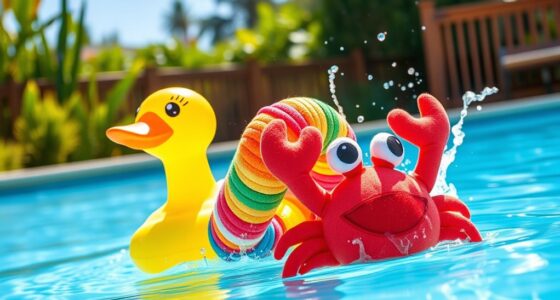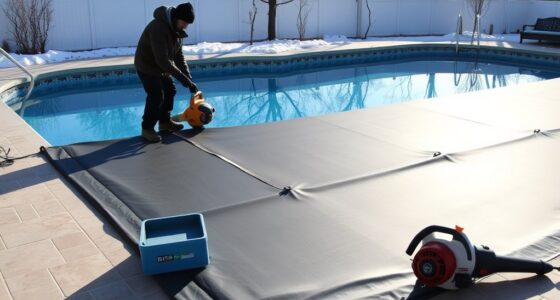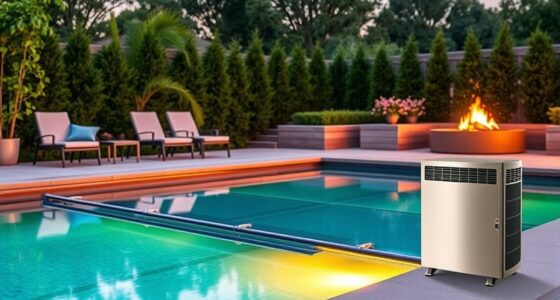To troubleshoot common pool problems yourself, start by testing your water chemistry and adjusting pH, chlorine, and alkalinity levels to fix cloudiness or algae issues. Check your pump and filter for clogs or leaks, and guarantee proper circulation. Inspect water levels for leaks and address low levels by fixing leaks or topping up. For more tips on solving these problems effectively, keep exploring how to maintain a clean, healthy pool.
Key Takeaways
- Regularly test and adjust water chemistry, including pH and chlorine levels, to prevent cloudiness and algae growth.
- Inspect and clean filters, skimmers, and return jets to ensure proper circulation and debris removal.
- Shock the pool with chlorine and brush surfaces to eliminate algae and bacteria buildup.
- Check for leaks using soap or dye tests and address any cracks or equipment issues promptly.
- Maintain consistent water levels and monitor equipment for signs of malfunction or leaks.
Diagnosing and Fixing Cloudy Pool Water
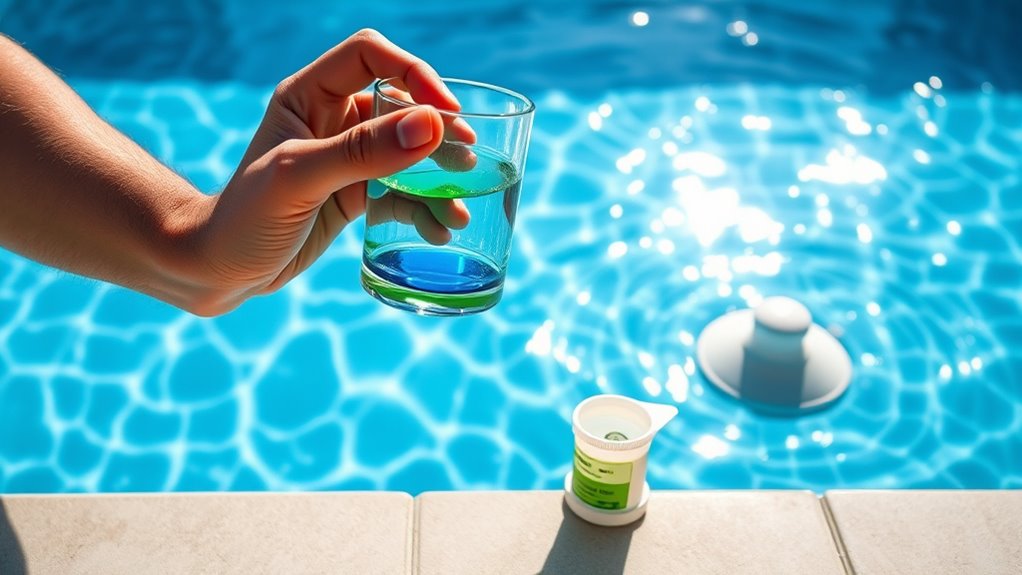
Cloudy pool water can be frustrating, but diagnosing the cause is the first step to fixing it. Start by checking your solar heaters, as they can sometimes cause temperature imbalances that lead to cloudiness. If your pool is heated unevenly, debris may accumulate more quickly, clouding the water. Also, inspect your pool cover; a dirty or poorly fitting cover can trap debris and bacteria, contributing to cloudiness. Test your water’s pH and chlorine levels—imbalances can promote algae growth and murkiness. Ensure your filtration system is working efficiently, and clean or backwash your filter regularly. Proper filtration and maintenance are essential for clear water, as consistent filter performance helps prevent debris buildup. Additionally, monitoring your chemical balance regularly ensures the water remains properly sanitized and clear. Maintaining proper oxidation levels can also reduce cloudiness caused by organic contaminants. Regular water testing is crucial for early detection of imbalances that can lead to cloudiness. Using energy-efficient filtration systems can improve overall water clarity by optimizing filtration performance. By identifying whether the issue stems from heating, covering, or chemical imbalance, you can take targeted steps to restore clear, inviting water.
Clearing Up Algae Growth
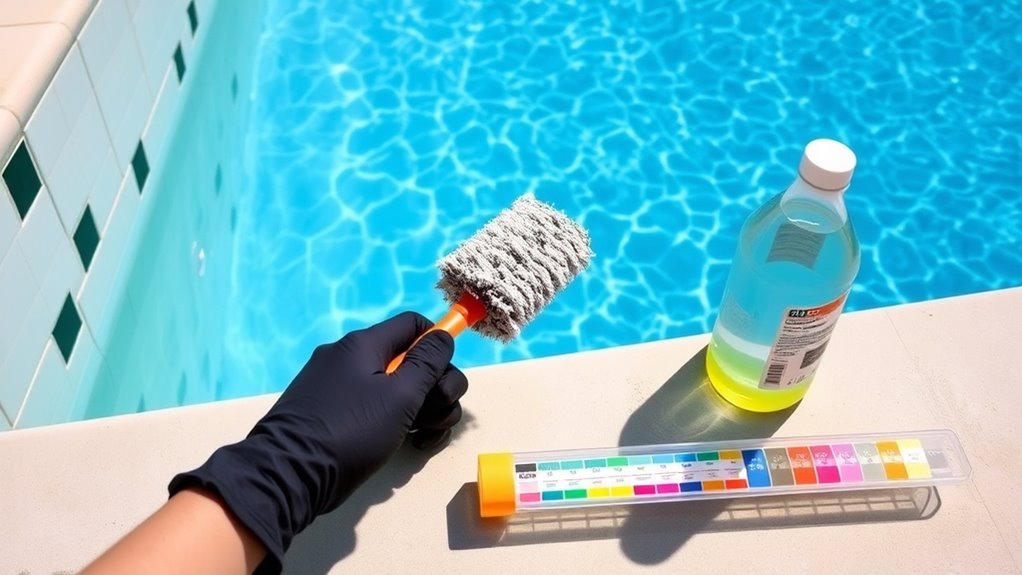
Wondering how to clear up algae growth in your pool? Algae control is essential for safe, clean water. First, shock the pool with a high dose of chlorine to kill algae and bacteria. Second, brush all surfaces thoroughly to remove algae buildup and guarantee proper pool sanitation. Third, run your filter continuously and backwash regularly to trap algae spores and debris. Maintaining proper pH and chlorine levels is key to preventing future algae growth. Regular maintenance and proper chemicals keep your pool clear and inviting. Using a pool cleaner can help automate debris removal and reduce manual effort. Additionally, adjusting to the appropriate chemical balance can prevent algae from returning and promote a healthier swimming environment. By staying vigilant and following these steps, you’ll restore your pool’s beauty and safety quickly. Remember, consistent pool sanitation is your best defense against algae’s return. Clear water is within your reach—just follow these simple algae control tips.
Troubleshooting Low Water Levels
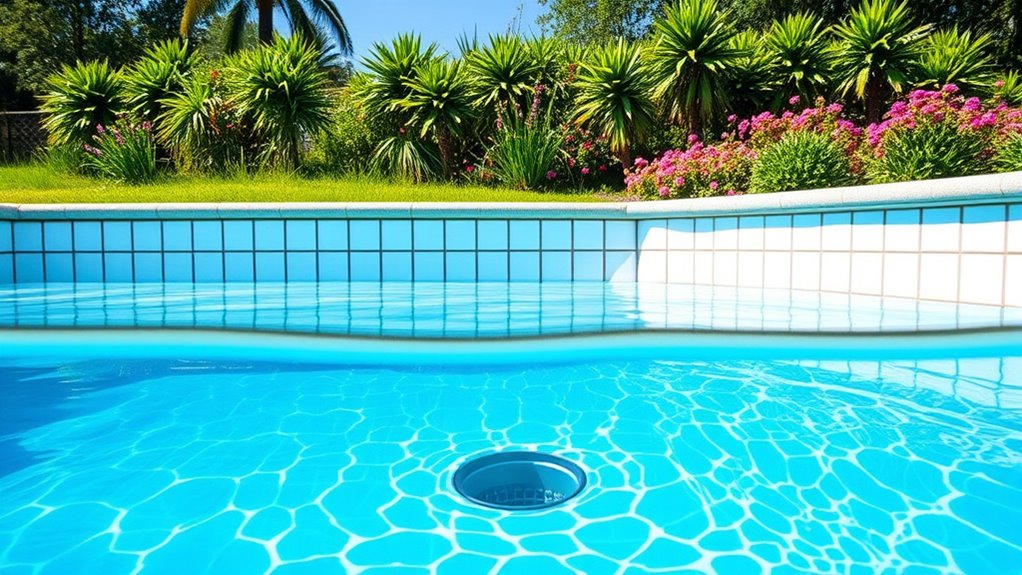
Low water levels in your pool can be caused by leaks, evaporation, or equipment issues, and addressing these promptly is essential to keep your pool functioning properly. Water evaporation and splash loss are common reasons for a drop in water level, especially during hot weather or heavy use. To monitor, check the water level regularly and note any sudden drops. Use this table to identify potential causes:
| Symptom | Possible Cause | Solution |
|---|---|---|
| Water drops quickly | High evaporation or splash loss | Reduce splash, cover pool |
| Water level low | Evaporation or leak | Inspect for leaks, top up |
| Consistent drops | Equipment issues | Check pump and filtration |
| Sudden drops | Splash loss | Add cover, reduce splashing |
| Gradual decline | Water evaporation | Maintain water level, cover |
Additionally, ensuring your pool’s filtration system is properly maintained can prevent equipment-related water loss. Regularly inspecting the skimmer and return jets can also help identify leaks or blockages that contribute to water level issues.
Repairing Pool Leaks

When you notice your pool’s water level dropping despite regular topping off, a leak could be the culprit. Inspect your pool liner for cracks or tears, as these are common leak sources. Check the skimmer basket; if it’s cracked or improperly sealed, water can escape. To repair a leak:
- Tighten or replace the skimmer basket to prevent water loss.
- Seal small tears in the pool liner with a specialized patch or adhesive.
- Use a leak detection dye to locate hidden cracks quickly. Proper diagnostic tools can make identifying leaks more efficient.
- Consider installing sensors that can detect water leaks early and notify you promptly for enhanced safety. Regular inspections and the use of optimal angles can also help maintain proper water levels and prevent leaks from worsening. Additionally, understanding how pool components interact can help prevent future issues. Addressing these issues promptly saves you money and prevents further damage. Regularly inspecting your pool’s liner and skimmer basket ensures that leaks are caught early, keeping your pool in top condition and your summer plans intact. Using monitoring devices can further assist in early leak detection and maintenance efforts.
Addressing Pump and Filter Malfunctions

When your pump refuses to turn on or makes strange noises, it’s a clear sign something’s off. Clogged or leaking filters can also hinder circulation and reduce efficiency. Addressing these issues promptly helps keep your pool running smoothly and saves you from bigger repairs later. Regular maintenance, such as inspecting and replacing worn components, can prevent these common problems from escalating. Ensuring Pool system components are in good condition involves periodic checks and understanding the importance of proper pump and filter maintenance. Additionally, monitoring water chemistry can prevent damage to equipment and maintain water clarity, especially as automation technologies become more integrated into pool systems.
Pump Not Turning On
Ever wonder why your pool pump refuses to turn on? It can be frustrating, but often the fix is simple. Here are three common causes to check:
- Blocked skimmer basket – Debris can restrict water flow, preventing the pump from starting. Make sure to clear out any leaves or debris.
- Tripped circuit breaker – Power interruptions stop your pump. Reset the breaker and see if it powers on.
- Pool heater issues – Sometimes, the heater’s safety features shut down the pump. Ensure the heater’s settings and connections are proper and that it isn’t causing the problem.
- Automated systems and controls – Modern pools often utilize automation technology to regulate equipment, and issues with these systems can also prevent the pump from operating correctly.
- Additionally, inspecting the electrical wiring and motor can help identify underlying issues that prevent startup. Regular maintenance of the skimmer basket and pool heater can help prevent future issues. Performing routine system checks can help catch problems early and keep your pool running smoothly, especially since glycolic acid can be used in pool maintenance routines to help exfoliate and maintain the skin around your pool area. Furthermore, understanding the security of electrical components can prevent potential hazards and ensure safe operation during troubleshooting.
Filter Clogs or Leaks
Clogged or leaking filters can cause your pool pump to malfunction by reducing water flow or creating pressure issues. Regular filter maintenance is essential to keep your system running smoothly. A clogged filter restricts water flow, making the pump work harder and risking damage. Leaks, on the other hand, reduce pressure and efficiency. To troubleshoot, check for visible cracks or loose fittings. Use leak detection techniques like soapy water to find leaks around seals and connections. Keep this table handy for quick reference:
| Filter Issue | Solution |
|---|---|
| Clogs | Clean or replace filter |
| Leaks | Tighten fittings, replace seals |
| Pressure Drop | Flush or backwash filter |
| Excessive Bubbles | Check for leaks in pump or filter |
| Unusual Noises | Inspect for debris or damage |
Stay proactive with filter maintenance to prevent costly repairs.
Unusual Pump Noises
Unusual noises from your pool pump often signal underlying issues with the pump or filter system. A squealing noise might mean the belt is slipping or needs replacement, while a grinding sound could indicate worn bearings or debris trapped inside. Addressing these sounds early can prevent costly damage. Additionally, inspecting the pump connection and ensuring it is secure can help maintain proper operation. Regular maintenance, including checking for clogged filters and ensuring proper water flow, can extend the lifespan of your equipment. Here are three common causes to check:
- The belt slipping or wearing out, causing a high-pitched squeal.
- Worn or damaged bearings producing a grinding sound.
- Debris or obstructions inside the pump, leading to irregular noises.
Ignoring these signs can lead to pump failure or reduced efficiency. Regular maintenance and prompt troubleshooting will keep your pool running smoothly, saving you time and money while ensuring safe, enjoyable swimming.
Fixing Uneven Water Circulation
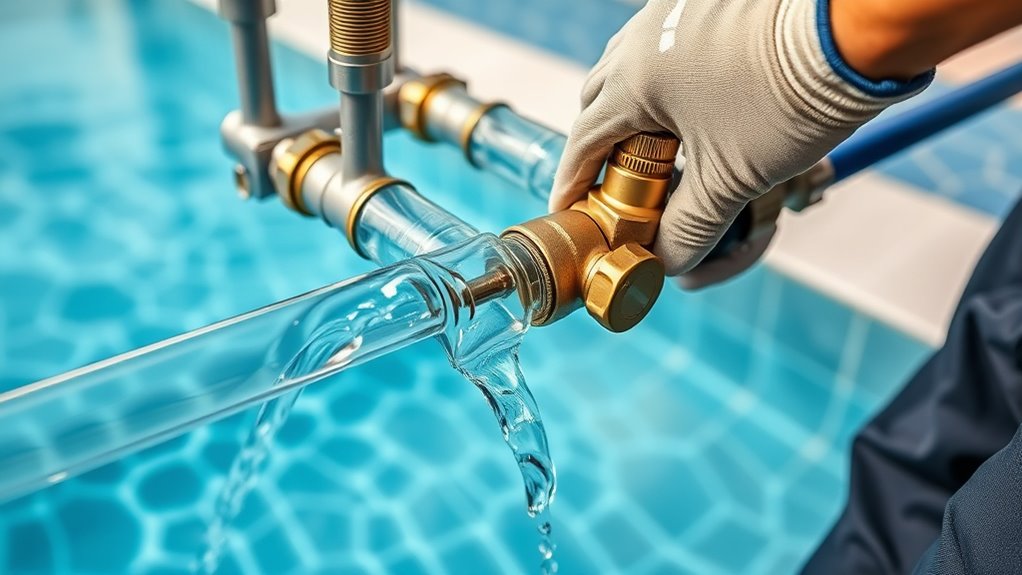
Uneven water circulation can cause spots of stagnation or uneven temperature in your pool, but you can often correct this issue with some simple adjustments. First, check the water flow to ensure your pump is functioning properly and that the skimmer and returns are clear of debris. Next, examine your circulation patterns; adjust the directional eyeballs on your return jets to promote even distribution of water. Properly balanced flow helps prevent dead zones where water moves slowly. Consider reconfiguring the alignment of return jets or adding a booster pump if needed. Regularly cleaning your pump basket and filter also supports consistent circulation. Small tweaks to water flow and circulation patterns go a long way in maintaining a healthy, evenly circulated pool. Additionally, using specialized spray tips can improve the efficiency of cleaning equipment, ensuring your pool’s circulation system remains unobstructed. Ensuring your pump maintains a proper water flow rate is essential for optimal circulation and avoiding stagnation issues.
Resolving Chemical Imbalance Issues
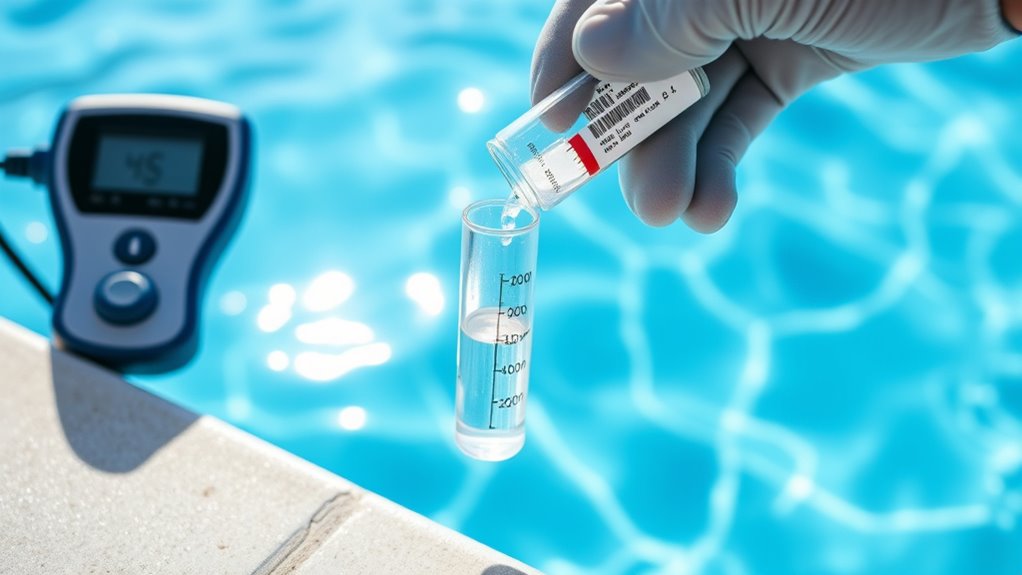
To keep your pool safe and inviting, you need to regularly test and monitor the water’s chemical levels. Once you identify any imbalances, you can adjust the chemicals accordingly to restore proper balance. Staying on top of these steps guarantees your pool remains clean, clear, and safe for swimming.
Testing and Monitoring
Monitoring your pool’s chemical levels regularly is essential to maintaining clear, safe water. Consistent water testing helps you catch imbalances before they turn into bigger problems. Make sure your sensor calibration is accurate so readings are reliable—this prevents guesswork and ensures precise adjustments. When testing, focus on key parameters like pH, chlorine, and alkalinity.
Here are three vital steps:
- Conduct regular water testing to identify imbalances early.
- Calibrate sensors periodically for accurate readings.
- Keep detailed records to track changes over time.
Adjusting Chemical Levels
Have you noticed your pool water becoming cloudy, itchy, or developing a strange odor? These issues often stem from improper chemical levels. To fix this, start with pH adjustment to bring your water’s pH into the ideal range of 7.2 to 7.6. Use a pH increaser or decreaser as needed, following the product instructions carefully. Once pH is balanced, focus on sanitizer balancing to keep your water safe and clear. Proper sanitizer levels prevent algae and bacteria growth. Test your water regularly and add sanitizer accordingly. Consistent chemical adjustments help maintain a healthy, inviting pool. Remember, balancing pH and sanitizer levels is key to resolving chemical imbalance issues and ensuring your pool stays clean and safe for swimming.
Repairing or Replacing Pool Lights
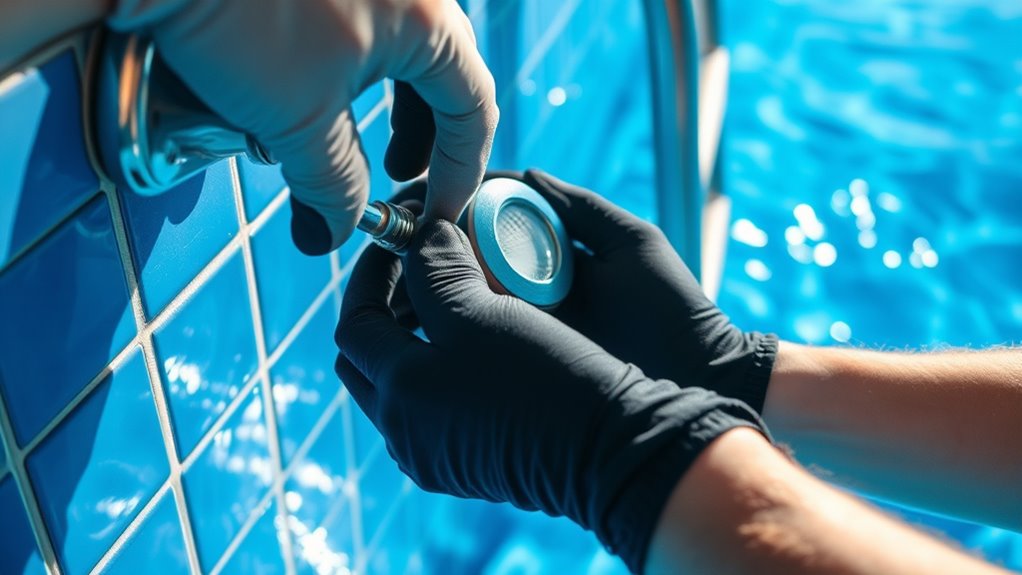
If your pool lights have stopped working or are flickering, fixing or replacing them can restore both safety and ambiance. To start, turn off the power and inspect the wiring for any damage or loose connections. Here are three key steps to guide you:
- Perform wiring inspection to identify and fix any faulty connections.
- Replace the LED bulb with a compatible LED replacement for improved brightness and energy efficiency.
- Test your lights after repairs to ensure the issue is resolved.
Handling wiring inspection carefully can prevent future problems, while upgrading to LED replacement offers a long-lasting, vibrant glow. With a little effort, you’ll bring back the inviting atmosphere of your pool and keep everyone safe.
Handling Stuck or Jammed Pool Equipment
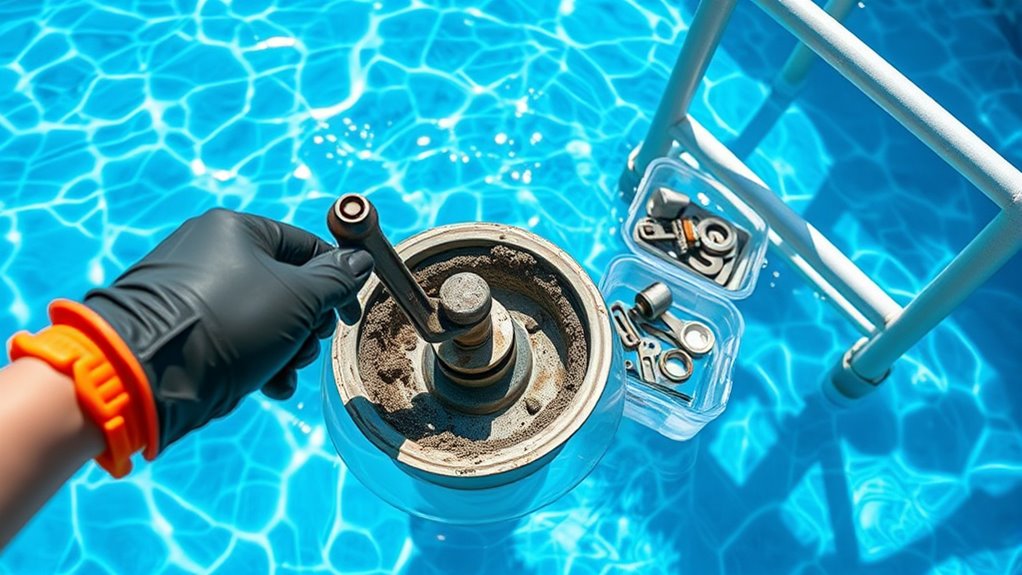
When pool equipment becomes stuck or jammed, it can disrupt your swimming season and cause frustration. To address this, start with pool cover maintenance; verify the cover isn’t tangled or damaged, which can affect equipment movement. Next, check the skimmer basket cleaning—removing debris helps prevent clogs that may lead to jams in your pump or filter. If a pool pump or skimmer remains stuck, gently turn off the power and try to free the component by hand or with tools, being careful not to damage parts. Lubricate moving parts if necessary, and inspect for obstructions. Regular maintenance, like cleaning the skimmer basket and keeping the pool cover in good shape, can reduce the chances of equipment jamming and keep your pool running smoothly.
Frequently Asked Questions
How Often Should I Test My Pool Water Chemistry?
You should test your pool water chemistry at least twice a week during the swimming season. Regular pool water testing helps you maintain proper chemical balance, preventing algae growth and cloudy water. If you notice heavy rainfall, lots of swimmers, or temperature changes, test more frequently. Consistent chemistry maintenance guarantees your pool stays clean, safe, and inviting, making your swimming experience enjoyable and hassle-free.
What Are the Signs of a Faulty Pool Pump?
Imagine your pool pump as the heart of your pool’s circulation. If you notice strange pump noise issues or the pump runs constantly, it could signal a faulty pool pump. Signs include reduced water flow, leaks, or the pump cycling on and off. A pump nearing the end of its lifespan often makes more noise or struggles to maintain pressure. Address these signs promptly to keep your pool clean and functioning smoothly.
How Can I Prevent Algae From Returning?
To prevent algae from returning, focus on algae prevention by maintaining proper water circulation. Run your pool pump regularly to keep water moving, which discourages algae growth. Keep your pH levels balanced and shock the pool periodically to eliminate any algae spores. Also, clean your skimmer and filter often to remove debris that can promote algae. Consistent maintenance and good water circulation are key to a clear, algae-free pool.
When Should I Replace My Pool Filter?
Imagine it’s the year 3000, and your pool filter still works—dream on! In reality, you should replace your pool filter when it reaches its lifespan, usually every 1-2 years depending on usage and water conditions. Follow your filter’s replacement schedule, and watch for signs like decreased water flow or increased debris. Regular maintenance keeps your pool crystal clear, so don’t wait too long to swap out the filter.
What Safety Precautions Are Needed When Repairing Pool Equipment?
When repairing pool equipment, you should prioritize safety by following pool ladder safety rules and chemical handling guidelines. Always turn off power and drain water before working on equipment. Use gloves and eye protection when handling chemicals, and make certain the area is well-ventilated. Secure ladders properly to prevent accidents, and never bypass safety features. Staying cautious helps prevent injuries and ensures a safe repair process.
Conclusion
Think of your pool as a mirror to your summer days—when it’s clear and inviting, it reflects your care and effort. Troubleshooting and fixing issues is like tending a garden; with patience and attention, you restore its beauty and balance. Every repair you make is a drop of water nurturing the whole. Keep nurturing your pool, and it’ll continue to be your personal oasis, shining brightly as a symbol of relaxation and joy.



